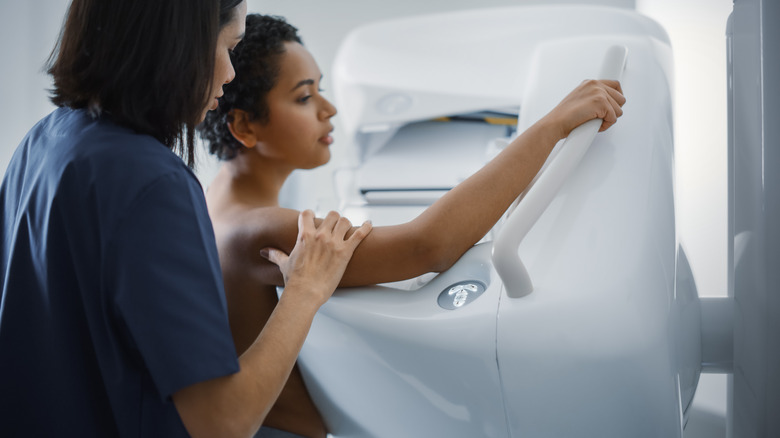How To Know If Breast Pain Really Requires A Mammogram
If you ever feel a pain that is out of the ordinary, specifically in your breasts, you may be running to WebMD to self-diagnose yourself with breast cancer based on your symptoms. But before you start to worry, it's important to know that there are many types of breast pain, and not all of them mean something scary. In fact, according to Pamela Wright, M.D., medical director of the Suburban Hospital Breast Center, there are ten different reasons you may feel pain in your breast, and most of them are common occurrences (via Hopkins Medicine).
If you have a sudden onset of pain that doesn't stick around for long, it's likely hormonal changes, which, per Wright, is the most common form of breast pain among women. If you feel pain in your breast and are expecting your period, you likely have nothing to worry about. Other reasons for breast pain include a pulled muscle, infection, medication side effects, or even wearing the wrong bra — but when does breast pain actually mean something concerning? Here's how to know if what you're feeling should be checked by a mammogram.
When pain in your breast should be checked by a doctor
Breast pain can be scary and cause alarm, but as physician Dr. Alison Chetlen explained to U.S. News & World Report, it is actually quite rare for the pain to be a sign of breast cancer. In addition to the normal things that can cause pain, like sore muscles or menstruation, others may feel pain if they are going through hormone therapy or have a hormonal imbalance, which mainly occurs in men.
But, if you have pain that seems to get worse as time passes, is centered on one specific spot, or hurts so much that your daily life becomes difficult, you're going to want to see a doctor. If you have a lump, any redness, or that warm tingling feeling in addition to the pain, it's likely a mammogram is needed to assess the problem. If you have any off feelings about your breast pain, be sure to advocate for yourself and your needs; it's better to air on the side of overly cautious than miss something down the line.
What to expect from a mammogram
If your doctor chooses to move forward with a mammogram, you will be getting a diagnostic mammogram, which is different from a routine mammogram that is done yearly for screening purposes. A diagnostic mammogram will take more images than a normal screening and search for any abnormalities in the breast. As previously stated, the chances of your pain being cancer are low, but if your doctor does see anything concerning in your mammogram, there are usually more steps to be taken. Your doctor may want to perform a biopsy or get an MRI done to further understand what they are looking at.
During a mammogram, you will remove all clothing from the waist up and stand in a machine that will compress your breast together to take images of the inner tissue. The process usually takes less than 30 minutes and for many, your doctor will be able to tell you your results fairly quickly.


